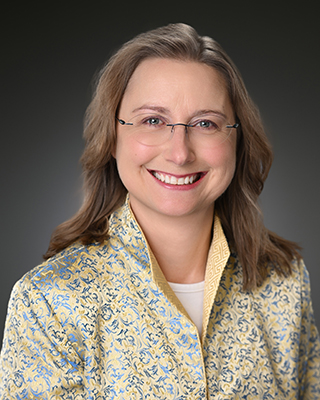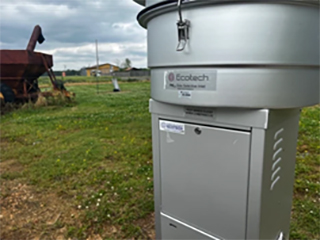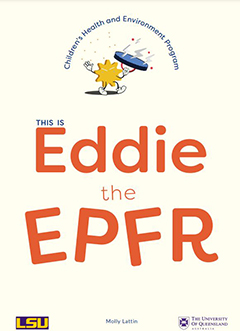September 30, 2024

Stephania Cormier, Ph.D., directs the LSU Superfund Research Program Center. (Photo courtesy of Cormier)
Stephania Cormier, Ph.D., began to envision a career in science after she volunteered in a biology lab during college and discovered a passion for research and the chemistry of life. A professor and mentor urged her to pursue graduate studies.
“Growing up in a rural area, I didn’t know any scientists — only doctors — so I naturally leaned toward that kind of field. But when I went to university and encountered new perspectives, I realized there were other careers out there,” she said. “That’s when my impressions of what I wanted to do began to change, and I was inspired to pursue a research career.”
After earning her Ph.D. in biochemistry and molecular biology and completing a postdoctoral fellowship at the Mayo Clinic, Cormier joined Louisiana State University (LSU) as an assistant professor, where she received an NIEHS Outstanding New Environmental Scientist (ONES) Award to study the effects of particulate matter on newborns’ cardiovascular and respiratory health.
“For the past 24 years, I’ve been dedicated to understanding how different environmental stressors, particularly air pollution from combustion-derived particulate matter, affect us as we age,” said Cormier, who now leads LSU’s NIEHS-funded Superfund Research Program (SRP) Center.
Expanding Our Understanding of Air Pollution
Cormier’s research increases our understanding of why air pollution exposure is particularly harmful to infants. Infants’ lung structure and immune responses differ from adults,’ influencing long-term disease outcomes.
“Infancy is a critical time for exposures because our lungs are not fully formed,” Cormier explained. “Environmental exposures early in life can alter lung function for the rest of your life.”
Her research led to collaborations with Barry Dellinger, Ph.D., a combustion chemist and the founding director of the LSU SRP Center. Cormier and Dellinger wrote about the air pollution risks to residents living near Superfund sites and the importance of regulations for protecting air quality.
“Dr. Dellinger was a great mentor, collaborator, and colleague. I can’t acknowledge his contributions enough,” Cormier reflected. (Dellinger died in 2016.)
Now, as LSU SRP Center director, Cormier continues to champion collaboration.
“The Superfund Research Program is unique because it allows us to work across fields. We integrate multiple disciplines, such as toxicology, environmental science, engineering, epidemiology, and health sciences, allowing for a more comprehensive understanding of how these particles impact human health and the environment,” she said.
After becoming director in 2011, Cormier prioritized research on the health effects of environmentally persistent free radicals (EPFR), a type of air pollutant embedded on particles. EPFRs are generated through thermal processes, such as wildfires or burning of hazardous waste at Superfund sites.
“When we first started looking at environmentally persistent free radicals, we were one of the first groups to identify them as this complex mixture of organics, metals, and particles that act as a unit,” Cormier said. “There was very little data on these systems.”
Among various discoveries, Cormier and colleagues have found that exposure to particulate matter, including EPFRs, increases illness severity and death from COVID-19.
Spurred by an observation from former postdoctoral fellow Sridhar Jaligama, Ph.D., that offspring of EPFR-exposed mice seemed unusually big, Cormier and team studied how EPFRs affect growth and metabolism. They found that mice exposed to EPFRs in utero grew larger and expended less energy than unexposed mice, suggesting that gestational EPFR exposure may contribute to obesity.
In 2024, Cormier received the prestigious Adel Sarofim award, an honor she describes as “tremendous.” Presented by the International Congress on Combustion By-Products and Their Health Effects, the award recognizes scientists who have made significant contributions to the field.
Collaborating With Communities
The LSU SRP often pursues research prompted by communities living near Superfund sites in Louisiana. Cormier and colleagues build working relationships with community members by listening to their needs and sharing observations and research findings.

Air sampling equipment at the home of a resident in Colfax, Louisiana. (Photo courtesy of LSU Superfund Research Center Project 3)
“Communities living near open-detonation sites and places where hazardous waste is burned often reach out to us for help in understanding whether their health concerns are connected to these activities,” Cormier said. “These communities are at the forefront of raising awareness about environmental issues and the health effects of pollution from combustion.”
Through the LSU SRP Center’s Community Engagement Core, led by Margaret Reams, Ph.D., investigators share their findings with communities and policymakers.
Developing messaging that resonates with the public requires a keen understanding of preconceptions about environmental health, Cormier explained.
“For instance, during wildfires, people are often told to stay indoors to avoid harmful air. However, we have found that levels of EPFRs and other pollutants can be 10 times higher indoors than outdoors. We’re raising awareness about how these pollutants change outside and inside air quality and the possible health risks,” she said.
Encouraging Budding Scientists

In collaboration with the University of Queensland, Australia, the LSU SRP Center released a children’s book about EPFRs. Cormier, an honorary professor of child health at the university, consulted on the book. (Photo courtesy of LSU SRP)
Cormier also promotes awareness of EPFRs by helping emerging scholars to engage with their communities about air pollution. The LSU SRP Center, in partnership with Southern University, leads an environmental health literacy class for 20 to 30 Upward Bound high school students from diverse communities in Baton Rouge each summer.
“One of their projects involved building low-cost air filters to deploy in homes,” Cormier said. “This hands-on experience engages high schoolers in research, much like I was engaged early in my academic career, and helps them bring valuable knowledge back to their families and communities.”
Cormier’s advice to emerging scholars is simple: “Seek out multiple mentors to guide you in different aspects of research, whether that be grant writing or leading a lab. Leverage this knowledge to help you succeed more quickly.”


